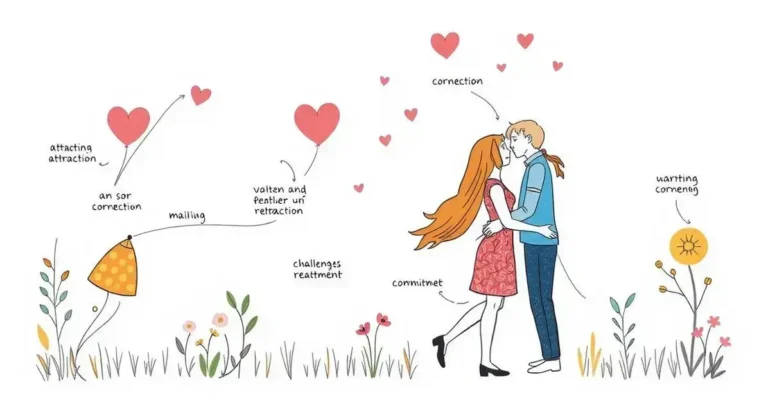Announcements
Relationship stages encompass four key phases: attraction and infatuation, deepening connection, challenges and growth, and commitment and stability.
Understanding these stages helps couples navigate their journey, fostering deeper emotional connections and ultimately leading to a lasting and fulfilling relationship.
Understanding the relationship stages is crucial for any couple seeking to strengthen their bond.
Announcements
Relationships evolve through various stages, each with unique dynamics and challenges.
By recognizing these phases, partners can navigate through emotions and commitments more effectively.
Announcements
What Are Relationship Stages?
Relationship stages refer to the different phases couples experience as their relationship grows.
Each stage brings its own set of emotions, challenges, and milestones.
Knowing these stages can help partners understand each other better and foster deeper connections.
The Importance of Identifying Stages
Recognizing the relationship stages allows partners to navigate through their journey with confidence.
It helps them to appreciate where they are and what to expect next.
By understanding these phases, couples can communicate openly and overcome difficulties together.
Overview of the Stages
Every relationship usually progresses through four primary stages: attraction and infatuation, deepening connection, challenges and growth, and commitment and stability.
Each stage shapes the relationship in significant ways.
Emotional Growth in Each Stage
During the initial stages, emotions can vary widely, spanning joy and excitement to uncertainty.
As relationships develop, partners often become more attuned to each other’s needs. Acknowledging these emotions is essential for moving smoothly to the next phase.
How to Recognize Your Stage
Open communication is the best way to identify what stage a relationship is in. Discuss feelings, fears, and expectations regularly.
This fosters a shared understanding and helps both partners feel secure.
The First Stage: Attraction and Infatuation
The first stage of any relationship is attraction and infatuation.
This stage is often filled with excitement and emotion. People may feel a strong desire to be close to their partner. This is the time when love can feel intense and wonderful.
What Happens During This Stage?
During attraction, individuals often experience a rush of emotions.
They may think about their partner all the time and feel butterflies in their stomach.
This is also when physical attraction plays a big role. A couple might enjoy spending time together and feel a strong connection.
The Role of Chemistry
Chemistry is very important in this stage. It can spark powerful feelings that can make a person feel euphoric.
Often, partners are drawn to each other’s physical appearance, charm, and personality. This chemistry can create an intense bond.
Challenges of Infatuation
However, infatuation can sometimes lead to unrealistic expectations.
People may overlook faults in their partner or the relationship. It is essential to recognize this to prepare for future stages.
Understanding This Stage’s Significance
Understanding feelings during the attraction and infatuation stage is vital.
It helps partners realize that while infatuation is special, it is not the only part of a lasting relationship.
Recognizing the difference between infatuation and true love can pave the way for a healthier connection.
Navigating the Second Stage: Deepening Connection

Navigating the second stage of a relationship is all about deepening connection. This phase follows the excitement of attraction and infatuation.
During this time, partners strive to build a stronger bond by getting to know each other better.
Understanding Each Other’s Needs
In this stage, communication becomes key. Couples need to share their desires, dreams, and even fears.
By openly discussing their feelings, partners can develop a much clearer understanding of each other’s needs.
Building Trust
Trust is a critical element in deepening connection. As partners learn more about each other, they also begin to rely on one another.
Consistency in words and actions helps reinforce trust, making it easier to express intimacy.
Spending Quality Time Together
Investing time together is another essential aspect.
Engaging in meaningful activities—like exploring interests, trying new experiences, or simply enjoying quiet moments—contributes to solidifying the relationship.
Setting Goals as a Couple
As partners grow closer, establishing shared goals becomes important.
Discussing future aspirations enhances the feeling of teamwork. It unites the couple in a common purpose and deepens their emotional connection.
Being Vulnerable
Lastly, vulnerability is crucial in this stage. Sharing insecurities or past experiences can help solidify the bond.
When partners feel safe to be vulnerable, they can develop a deeper emotional intimacy that strengthens their relationship.
The Third Stage: Challenges and Growth
The third stage of relationships is where challenges and growth come into play.
This phase occurs after partners have developed a deeper connection but often involves navigating hurdles together.
While these challenges can be difficult, they also lead to personal and relational growth.
Identifying Challenges
Challenges can arise from various sources, including communication issues, differing values, and external stressors like work or family complications.
Recognizing these challenges is the first step toward dealing with them effectively.
Effective Communication
In this stage, clear communication is vital. Partners need to discuss their feelings honestly, even when it feels uncomfortable.
This transparency helps build trust and allows couples to find solutions together.
Adapting to Change
Every relationship goes through changes. Personal growth, career shifts, or life events can affect how a couple interacts.
Being open to adaptation and compromise helps partners grow together through these changes.
Conflict Resolution Skills
Learning to resolve conflicts healthily is crucial during this stage. Couples can practice discussing disagreements calmly and respectfully.
Focus on finding solutions rather than assigning blame to strengthen the relationship.
Embracing Growth
Although challenges can be tough, they often lead to significant growth.
Couples who work through difficulties together emerge stronger and more connected. Embracing personal growth and supporting each other fosters a deep and lasting bond.
Reaching the Fourth Stage: Commitment and Stability
Reaching the fourth stage of a relationship is all about commitment and stability.
This stage signifies a solid foundation where partners feel secure in their love for each other. It marks a significant transition from the earlier phases of romance and challenges.
What Does Commitment Mean?
Commitment goes beyond just the act of saying “I love you.” It means making a conscious choice to stay together and support one another.
Partners are dedicated to nurturing their relationship and facing life’s ups and downs as a team.
Building a Stable Relationship
Stability is achieved through trust, mutual respect, and open communication.
At this stage, couples often feel comfortable discussing serious topics like future plans, finances, and family.
This openness fosters an environment where both partners feel valued and heard.
Setting Shared Goals
Couples in this stage often set shared goals. These might include plans for living arrangements, saving for a home, or family expansion.
Working together towards these goals strengthens the bond between partners and creates a sense of unity.
Maintaining Connection
While commitment and stability are essential, it’s crucial to maintain the connection that brought partners together.
Regular date nights, open conversations, and shared activities help keep the spark alive in a committed relationship.
Facing Future Challenges Together
Even in a stable relationship, challenges may arise. Strong commitment helps partners work through any difficulties together.
Facing problems as a team creates deeper trust and strengthens the overall relationship.
FAQ – Frequently Asked Questions about Relationship Stages
What are the different stages of a relationship?
The stages of a relationship typically include attraction and infatuation, deepening connection, challenges and growth, and finally, commitment and stability.
How can I tell if I am in the attraction stage?
You may experience strong feelings of excitement and infatuation, often thinking about your partner frequently and feeling a strong physical attraction.
Why is communication important in a relationship?
Clear communication helps partners understand each other’s needs and feelings, allowing them to navigate challenges and deepen their connection.
What should I do when faced with challenges in my relationship?
It’s important to discuss your feelings and work together to resolve issues. Open communication can lead to personal and relational growth.
How can couples maintain their connection in a long-term relationship?
Regular date nights, shared activities, and open discussions about life goals can help maintain the connection and keep the relationship vibrant.
What does commitment in a relationship mean?
Commitment means making a conscious choice to stay together and support one another, building a stable foundation for your relationship.







